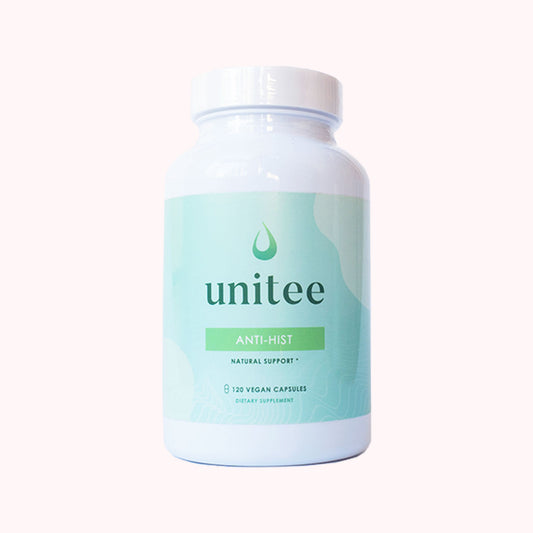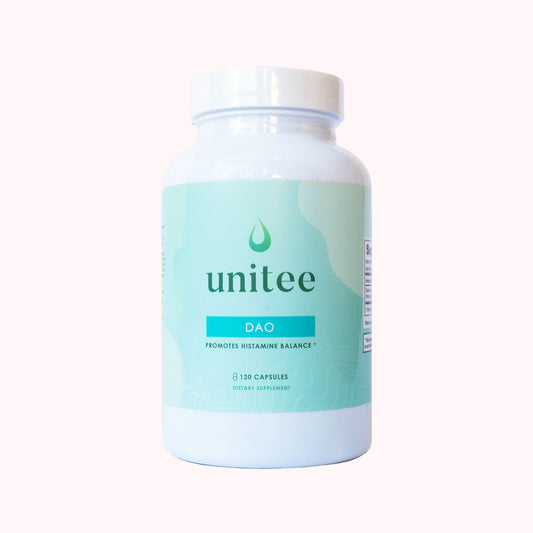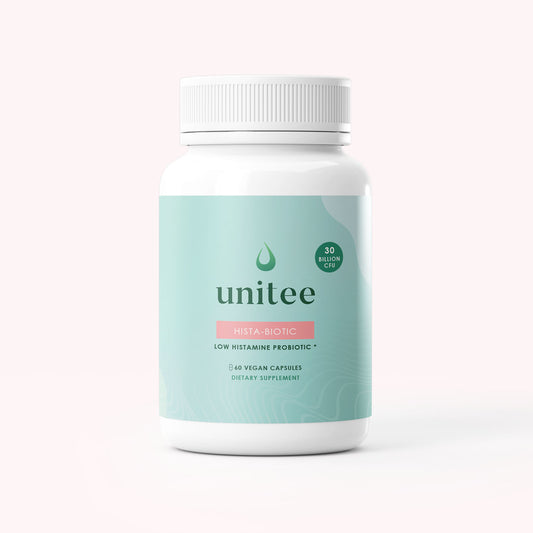Living with histamine intolerance is hard! And it’s not because of all the bothersome symptoms… sure, they can be debilitating, too, but I’m talking about navigating your diet! Even with a comprehensive list of low and high histamine foods guiding your choices, you may feel like you’re always missing out, having to eat bland and boring foods when everyone else can enjoy whatever they please!
That’s certainly how I felt as I was going through my own journey, healing from histamine intolerance. Well, until I figured out how to make my foods more interesting and downright delicious, using only what I had available on my low histamine list.
Let me tell you, I made many tasty meals… but there was one thing I couldn’t get enough of. And that was butternut squash.
Butternut squash was an absolute gift! It satisfied so many of my desires while I was following a restrictive diet; it was warm and soothing on the days I needed comfort, sweet and cooling on the days I had cravings, and overall a nutrition powerhouse I was happy to be able to include in most of my meals.
So, for those of you who’ve asked me the question, “is butternut squash low histamine?”, I’m here to tell you… it most certainly is. And today we can count the ways you can include it in your low histamine diet.
Is Butternut Squash Low Histamine? Here Are 5 Healthy Reasons to Love It
As I mentioned above, butternut squash is a nutritional powerhouse. Here are 5 reasons to love it:
1. Vitamin A: Just 1 cup of butternut squash contains almost 500% of your recommended daily intake of vitamin A. Why is this important for those of you living with histamine intolerance? Well, research has shown a correlation between low intake of vitamin A and heightened inflammatory responses, which, you guessed it, include the release of histamine (1). Vitamin A may also help to modulate how histamine receptors are expressed throughout the body, which means vitamin A plays a role in how sensitive your tissues are to histamine and how strongly they react to the presence of this biogenic amine.
2. Vitamin C: One cup of butternut squash provides around 50% of your daily required intake of vitamin C. Vitamin C is important for those of you living with histamine intolerance due to its anti-inflammatory and immune modulating properties. In fact, research shows low levels of vitamin C can increase the risk of histamine intolerance (2), and that histamine intolerance symptoms may decrease by almost 40% when people take higher doses of vitamin C (3).
3. Antioxidants and phenolic compounds: Antioxidants are essential to good health in everyone, but, if you’re living with histamine intolerance, they’re even more important. You see, when your body is rife with inflammation, your body produces more chemicals called reactive oxygen species due to the heightened metabolic processes taking place as a result of the inflammation. These free radicals damage tissues, and can contribute to more inflammation. Antioxidants are necessary in large amounts to neutralize these free radicals so they have less of an opportunity to attack tissues. Fortunately, butternut squash is a wonderful source of at least 10 antioxidant phenolic compounds (4). Now, I’ll say something that may surprise you: where possible, be sure to eat the skin of your butternut! Why? It has been shown to contain more of these antioxidants than the pulp (5). So, by eating both, you’re sure to boost your free radical-fighting antioxidant levels.
4. Fiber: Including a good amount of fiber in the diet has many health benefits. Unfortunately, when following a restrictive diet such as the low histamine one, it might be hard to meet your optimal daily intake of fiber. It’s really important to try, as fiber is an essential nutrient when it comes to supporting the health of the gut microbiome, and the health of the gut microbiome is critical for maintaining optimal immune regulation. Through various mechanisms, fiber is able to reduce mast cell degranulation (6), which reduces the amount of histamine released into the body. Fiber is also able to help reduce the production of inflammatory chemicals in the body, further contributing to lower inflammation and fewer flares of histamine intolerance symptoms. Just one cup of butternut squash contains 7g of fiber, which sets you well on your way to achieving the ideal 25-30g per day.
5. Low glycemic index: Because of its high fiber content, butternut squash is considered a low glycemic index (GI) food. A low GI rating of 51 means the food has little impact on blood sugar, which is important for those of you living with histamine intolerance as spikes and dips in blood sugar levels correlates with increased histamine symptoms.
Butternut squash is also low in calories, contains a great amount of other important minerals and vitamins, and is a great addition to your diet for so many other health benefits.
It is, however, noteworthy to mention, some people following a low histamine diet and including butternut squash in their meals may have a reaction! Now, it’s not because butternut squash causes a histamine reaction. In fact, it’s because butternut squash is packed full of those wonderful phenols I mentioned earlier. And people with a coexisting salicylic acid intolerance often don’t do well with foods rich in phenols because salicylates are a type of phenolic compound (7). So, if you do find yourself reacting to butternut squash despite it being low histamine, it’s probably best for you to investigate whether your histamine reactions are as a result of another intolerance, or you have more than one sensitivity going on!
Now for the fun part! For those of you who, like me, do well with butternut squash as part of your low histamine diet, here are some ways you can include it in your meals.
7 Ways to Include Low Histamine Butternut Squash in Your Meals
1. Make fries. Instead of potato fries, use butternut squash and make them in the same way.
2. Have a tasty and easy-to-digest soup. Puree your cooked butternut squash, combine with coconut cream and voila, you have a smoothing bowl of creamy butternut squash soup.
3. It’s a great pasta sauce. You won’t even miss the tomatoes! Puree roasted butternut squash and add a little coconut cream for a deliciously rich and healthy low histamine pasta sauce.
4. Toast? Using the larger round end of the butternut squash, cut into ½ inch slices, then place on a baking tray. Drizzle with olive oil and bake for 30-40 minutes until lightly browned. Top with your favourite low histamine ingredients and enjoy!!
5. Caramelized cubes! Chop into cubes, toss with olive oil and salt, and roast in the oven until brown and caramelized. They’re delightful as a snack or side dish.
6. A sweet and salty snack. Simply roast shavings of butternut squash in the oven drizzled in olive oil and sprinkled with salt for a crispy, crunchy snack.
7. Replace banana in recipes. Many of my clients don’t tolerate bananas, which are often used in low histamine recipes. Instead, substitute the banana with roasted and pureed butternut squash! It provides the sweetness and moisture along with all of the benefits mentioned above. It’s great for muffins, breads, and even pancakes. Yum!
There’s one more way to use butternut squash in your low histamine diet. And I’ve saved the best for last…
Here’s My Low Histamine Butternut Squash Mousse Recipe
This recipe might look familiar, and for good reason. I posted my Low Histamine Pumpkin Mousse Dessert Recipe around fall because what are the holidays without pumpkin, am I right!?
Well, you can turn this holiday treat into a regular one using butternut squash! All you have to do is replace the 2 cups of pumpkin puree with butternut squash and you have a sweet, sweet, low histamine healthy mousse!
Ingredients:
2 cups of roasted and pureed butternut squash
⅓ cup of maple syrup, or you can use raw honey
1 teaspoon of vanilla extract (make sure it’s alcohol-free)
¼ teaspoon of freshly grated ginger, as finely grated as possible
1 can of full fat coconut milk
Directions:
1. Place your unopened can of full fat coconut milk in the fridge at least 8 hour before you plan on making this recipe. It allows the fat to solidify, which is key to a good mousse texture in this recipe.
2. When you’re ready to start making your mousse, open the can and scoop out the solid white part and place it into a mixing bowl.
3. Using a high speed hand mixer, whip the solids into a fluffy whipped cream and set aside.
4. In a separate bowl, combine the butternut squash puree, grated ginger and maple syrup or honey. Mix well to combine.
5. Gently fold the whipped coconut cream into the butternut squash mixture. Be careful not to overmix as you want as much air to remain to give it that fluffy texture.
6. Chill the finished mousse in the fridge for at least 2 hours before eating.
It’s a great recipe to make ahead of time to eat when you feel like a little treat, or when you’re with friends and they’re all tucking into something delicious that you can’t have.
I hope you end up loving butternut squash as much as I do, and that it brings some brightness and flavour to your low histamine diet!
References:
1. Wiedermann U, Chen XJ, Enerbäck L, Hanson LA, Kahu H, Dahlgren UI. Vitamin A deficiency increases inflammatory responses. Scand J Immunol. 1996;44(6):578-584.
2. Jarisch R, Weyer D, Ehlert E, et al. Impact of oral vitamin C on histamine levels and seasickness. J Vestib Res. 2014;24(4):281-288.
3. Johnston CS, Martin LJ, Cai X. Antihistamine effect of supplemental ascorbic acid and neutrophil chemotaxis. J Am Coll Nutr. 1992;11(2):172-176.
4. Kamiloglu S, Koc Alibasoglu E, Acoglu Celik B, et al. Bioaccessibility of Carotenoids and Polyphenols in Organic Butternut Squash (Cucurbita moschata): Impact of Industrial Freezing Process. Foods. 2024;13(2):239.
5. Yang, Z., Shi, L., Qi, Y., et al. Effect of processing on polyphenols in butternut pumpkin (Cucurbita moschata). Food Bioscience. 2022. 49: 101925.
6. Folkerts J, Stadhouders R, Redegeld FA, et al. Effect of Dietary Fiber and Metabolites on Mast Cell Activation and Mast Cell-Associated Diseases. Front Immunol. 2018;9:1067. Published 2018 May 29.
7. Suliburska, J., Syabani Cholik, R. Risks and benefits of salicylates in food: a narrative review. Nutrition Reviews. 2024. 82(11):1594–1604.







